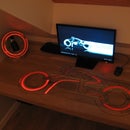Introduction: Iron Washer Valet
I wanted to work the iron because the work of iron is something that I find beautiful, attractive or even hypnotic ...
I was looking for ideas on the net and I came across works of art made with iron rings. But as I like works that can be used and not only look, I thought, and why not make a valet!
It only remained for me to think about how to do it!
Step 1: Materials
Materials :
- iron washer 18mm : about 1000
- iron washer 16mm : about 2000
- iron washer 14mm : about 1000
- concrete : 6*35kg
- plastic bust mannequin : 1
- strips of plaster : 4 * 10m
- aerosol paint aluminiun color : 1
- millstone : 1
- shale stone 1m*75cm*8cm
- drill : 1
- electric welding machine : 1
- welding rod : 80
Step 2: Plaster Band
Because I can not solder directly on the plastic bust and I only want the solder trace to be visible => I need a mold.
After making the mold with the strips of plaster, I try to weld directly on the plaster tape. Of course, the plaster band burns a bit, but the real flaw was that it was not too rigid and that the iron washers were not aligned :(
By cons as I do not have plastic arms, I decided to make it from strips of plaster. A friend of mine is trying adventure! Of course I did not tell him that it will make him a free hair removal and 2-3 cuts of cutter during the removal :).
Step 3: Concrete Mold
Ok, I have to make a beefier mold!
I'm going on a concrete mold: it's beefy and it does not cost much :)
I realize the formwork with wooden planks. I filled the formwork with concrete. It only remains for me to immerse half the plastic bust. As the bust tends to go up, I position on some weights.
So I realize 2 molds, one for the front, another for the back side.
For the arm, I filled the strips of plaster with concrete, it gives me a concrete arm. From this concrete arm, I realize the same process as for the plastic bust. Little story, when making the mold of the arm, I was wrong and I realized twice the same face of the arm, so I had to make another concrete mold to have the missing face :(
Step 4: Welding
Welding is the most time consuming ...REALLY!
On the one hand because it's almost the first time I welded with welding rods. The iron washer welding has a peculiarity, it must be fast, otherwise the washer melts because of the heat. It took me some welding rods to train. At first I positioned the iron washers on a sticker, which made me waste a lot of time ... With experience I no longer used stickers or even gloves, even if I burned once.
Step 5: Sanding, Assembly, Painting
Once both sides are done, do not forget to sand the inside.
Indeed, when both sides are assembled, it will be difficult or impossible to sand the inside.
Then finally comes the moment to assemble both sides. I used the plastic bust to mark the areas to be welded on both sides. Once the zones are marked, all that remains is to weld. There is still a disadvantage, the traces of welds will not be inside but visible on the outside. But fortunately there are not many.
Once both sides assembled, I painted them with an aluminium spray can. I had to paint the areas that I could not reach when sanding.
Step 6: Central Metal Rod
After making the iron washer bust, I placed a metal rod inside to allow it to be fixed later.
The positioning of this rod had to be perfect, otherwise the bust would not have been perfectly vertical. I first positioned 2 rods on 2 different axes. I then welder the main rod on these 2 rods. I made a notch in the stem to limit later the rotation of the bust on its axis. For the arm I used a single rod.
Step 7: Stone Base
As the bust is metal and my floor is wood, I had to find a base in a different material.
It was also necessary that the base is heavy. So I chose to make a stone base. I bought a shale stone that I re-cut a bit with a small grindstone. The hardest thing was to drill it in 2 places for future support rods.
Step 8: Sanding
The sanding was not too difficult or too long.
But I have not managed to sand everywhere because the sander does not go everywhere ...
Finally do not forget a layer of anti-rust :)
Step 9: Final Assembly
The final assembly was simple and I am very satisfied with the result.




